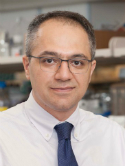Genomic characterization of ERBB2-driven biliary cancer and a case of response to ado-trastuzumab emtansine Journal Article
| Authors: | Mondaca, S.; Razavi, P.; Xu, C.; Offin, M.; Myers, M.; Scaltriti, M.; Hechtman, J. F.; Bradley, M.; O'Reilly, E. M.; Berger, M. F.; Solit, D. B.; Li, B. T.; Abou-Alfa, G. K. |
| Article Title: | Genomic characterization of ERBB2-driven biliary cancer and a case of response to ado-trastuzumab emtansine |
| Abstract: | PURPOSE Biliary tract cancers (BTCs), which include intrahepatic cholangiocarcinoma (ICC), extrahepatic cholangiocarcinoma (EHC), and gallbladder cancer (GBC), have limited treatment options. We sought to comprehensively examine the clinical and molecular characteristics of BTCs with amplification or mutation of ERBB2. METHODS Demographic, outcome, and treatment response data were collected for patients with ERBB2-altered BTC identified by next-generation sequencing with Memorial Sloan Kettering-Integrated Mutation Profiling of Actionable Cancer Targets from 2014 to 2018. RESULTS A total of 517 patients with BTC underwent next-generation sequencing (ICC, n = 313; EHC, n = 93; GBC, n = 111). Twenty-eight patients (5.4%) had ERBB2 alterations, including 2.7% with ERBB2 gene amplification, 2.3% with ERBB2 mutation, and 0.4% with concurrent amplification and mutation. The prevalence of ERBB2 gene alterations was significantly higher in GBC (12.6%) than in ICC (2.2%) and EHC (7.5%; P,.001). In ERBB2-amplified tumors, the median fold change was 6.4 (range, 2.1 to 19.7), while in ERBB2-mutant tumors, the most frequent mutated domain was the extracellular domain (32%), with all mutations in this region involving the S310 codon. Frequent co-altered genes in this cohort were TP53 (54%), PIK3CA (21%), and CDKN2A (18%); KRAS amplification/mutation was found in 7% of patients. One patient with ERBB2-amplified EHC who enrolled in a basket trial (ClinicalTrials.gov identifier: NCT02675829) had a partial response to the human epidermal growth factor receptor 2-targeted antibody-drug conjugate ado-trastuzumab emtansine. CONCLUSION ERBB2 alterations are present in 5.4% of BTCs. When present, the degree of ERBB2 gene amplification is often high, and S310 codon mutations are the most common hotspot. These features, along with the presented case, support further development of human epidermal growth factor receptor 2-targeted therapy in ERBB2-mutant and/or -amplified BTC. © 2019 by American Society of Clinical Oncology |
| Keywords: | adult; cancer survival; treatment response; aged; middle aged; gene mutation; major clinical study; overall survival; missense mutation; drug withdrawal; gemcitabine; progression free survival; multiple cycle treatment; gene amplification; prevalence; ca 19-9 antigen; epidermal growth factor receptor 2; cohort analysis; protein p53; oncogene; genomics; bile duct carcinoma; cyclin dependent kinase inhibitor 2a; oncogene k ras; gallbladder cancer; pik3ca gene; biliary tract cancer; bile duct cancer; molecularly targeted therapy; clinical outcome; trastuzumab emtansine; high throughput sequencing; very elderly; human; male; female; priority journal; article; antibody drug conjugate |
| Journal Title: | JCO Precision Oncology |
| Volume: | 3 |
| ISSN: | 2473-4284 |
| Publisher: | American Society of Clinical Oncology |
| Date Published: | 2019-10-17 |
| Language: | English |
| DOI: | 10.1200/po.19.00223 |
| PROVIDER: | scopus |
| PMCID: | PMC7446346 |
| PUBMED: | 32923849 |
| DOI/URL: | |
| Notes: | Article -- Export Date: 1 July 2020 -- Source: Scopus |
Altmetric
Citation Impact
BMJ Impact Analytics
MSK Authors
Related MSK Work















